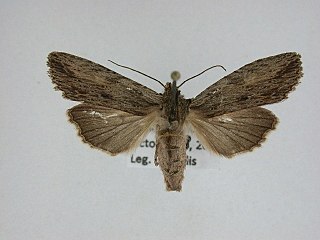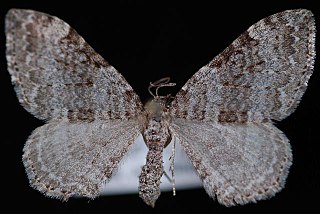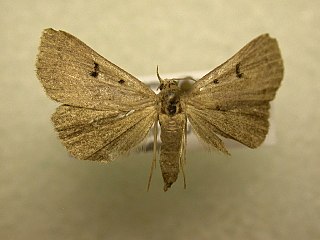Phrygionis privignaria is a moth in the family Geometridae described by Achille Guenée in 1858. It is distributed over the Caribbean, North, Central and South America.
Tarache terminimaculata, the curve-lined bird-dropping moth, is a species of moth in the family Noctuidae. The species was described by Augustus Radcliffe Grote in 1873. It is found in North America.

Lithophane signosa, the signate pinion or sycamore pinion moth, is a species of moth in the family Noctuidae. The species was described by Francis Walker in 1857. It is found in North America.

Matigramma emmilta is a species of moth in the family Erebidae. It was described by John G. Franclemont in 1986 and is found in North America, where it has been recorded from Arizona, New Mexico and Texas. The habitat consists of mountain canyons and deserts.
Plagiomimicus aureolum is a species of moth in the family Noctuidae. It was described by Henry Edwards in 1882 and is found in North America, where it has been recorded from Arizona, western Texas and New Mexico.

Homorthodes furfurata, the northern scurfy Quaker moth or scurfy Quaker moth, is a species of moth in the family Noctuidae . It was described by Augustus Radcliffe Grote in 1874 and is found in forest habitats in North America. Its range extends across the continent, to south-eastern Canada, Massachusetts, New York, and Mississippi. In the west it ranges south to California, Arizona, New Mexico and Texas.
Sphingicampa bisecta, the bisected honey locust moth, is a species of moth in the family Saturniidae. The species was described by Joseph Albert Lintner in 1879. It is found in North America.
Nepytia janetae is a species of moth in the family Geometridae . It was described by Frederick H. Rindge in 1967 and is found in North America.

Macrochilo hypocritalis, the twin-dotted macrochilo, is a species of moth in the family Erebidae. The species was first described by Douglas C. Ferguson in 1982. It is found in North America, where it has been recorded from the eastern United States. The habitat consists of open, herb-dominated wetlands.

Properigea niveirena is a species of moth in the family Noctuidae. It was described by Leon F. Harvey in 1876 and is found in North America, where it ranges from Vancouver Island, through western British Columbia, Washington and Oregon south to California and the border with Mexico, then east to New Mexico through southern Arizona.

Xanthorhoe macdunnoughi is a species of moth in the family Geometridae. It was first described by Louis W. Swett in 1918 and is found in North America, where it has been recorded from open wooded areas in western North America, ranging east to western Alberta and south to California.

Bleptina inferior, the inferior owlet moth, is a species of moth in the family Erebidae. It was described by Augustus Radcliffe Grote in 1872 and is found in North America, where it has been recorded from Iowa to Massachusetts, south to Texas and Florida.
Annaphila arvalis is a species of moth in the family Noctuidae. It was described by Henry Edwards in 1875 and is found in North America, where it has been recorded from foothill canyons and riparian habitats in south-eastern British Columbia, eastern Washington, north-central Oregon, south to southern California.
Parabagrotis insularis is a species of moth in the family Noctuidae. It is found in North America, where it has been recorded from southern Vancouver Island, along the Pacific Coast through California to near the border with Mexico. The species was described by Augustus Radcliffe Grote in 1876.
Amblyscirtes linda, or Linda's roadside skipper, is a species of grass skipper in the family Hesperiidae. It was described by Hugh Avery Freeman in 1943 and is found in North America.
Nystalea indiana, or Grote's tropical prominent moth, is a species of prominent moth in the family Notodontidae. It was described by Augustus Radcliffe Grote in 1884 and is found in North America.
Chaetaglaea fergusoni, or Ferguson's sallow moth, is a moth in the family Noctuidae. It was described by Vernon Antoine Brou Jr. in 1997 and is found in North America.

Metalectra quadrisignata, the four-spotted fungus moth, is a species of moth in the family Erebidae. It is found in North America, where it has been recorded from Arizona, Florida, Georgia, Indiana, Iowa, Kentucky, Louisiana, Maine, Maryland, Massachusetts, Michigan, New Brunswick, New Hampshire, New Jersey, North Carolina, Ohio, Oklahoma, Pennsylvania, Quebec, South Carolina, Tennessee, Texas, Virginia, West Virginia and Wisconsin. The species was described by Francis Walker in 1858.
Elaphria deltoides is a species of cutworm or dart moth in the family Noctuidae. It is found in North America.

Elaphria exesa, the exesa midget moth, is a species of cutworm or dart moth in the family Noctuidae. It is found in North America.









